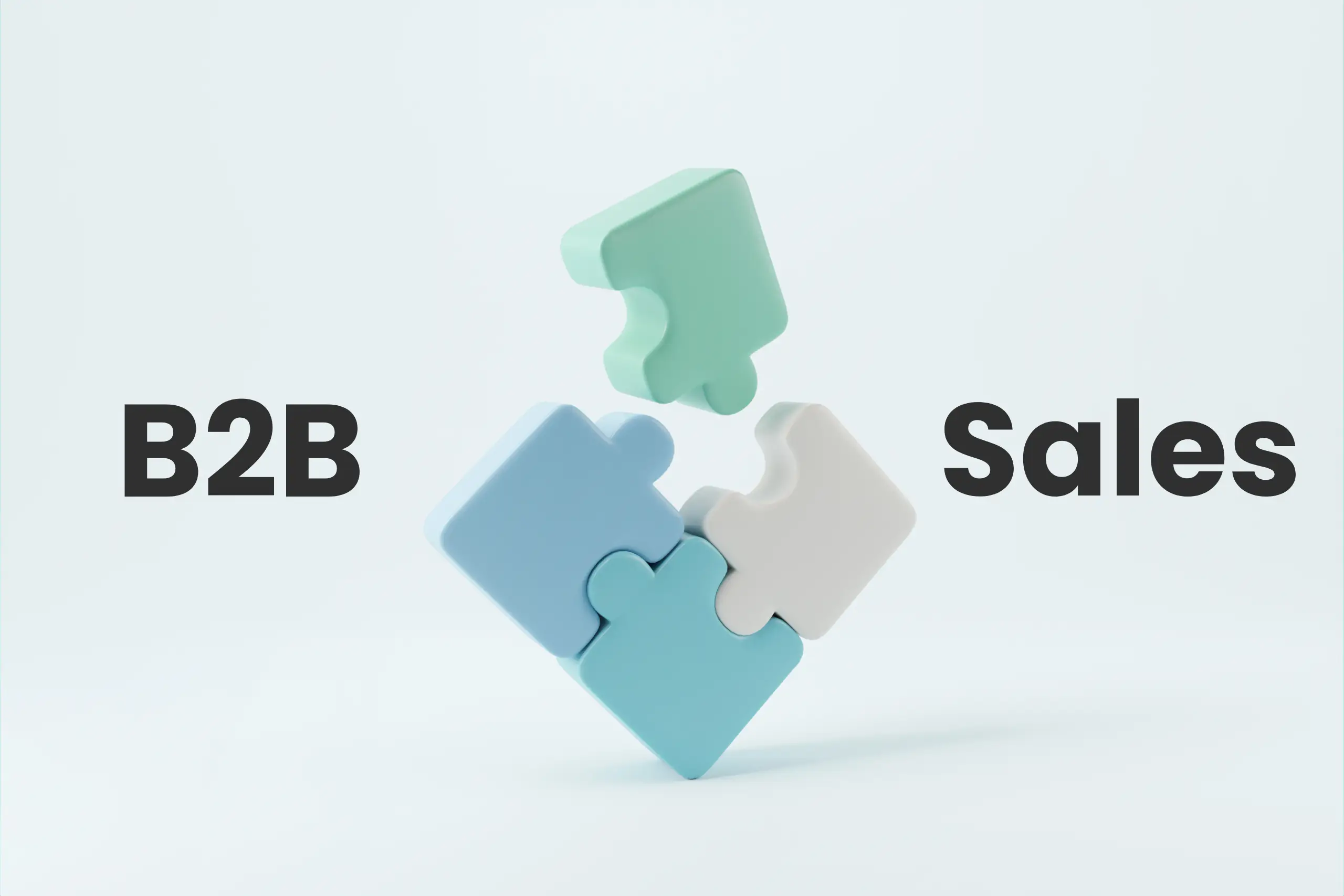Table of Contents
ToggleIn the intricate web of commerce, B2B sales, or business-to-business sales, form the backbone of transactions that power industries worldwide. Unlike consumer-focused sales, B2B sales involve companies selling their products or services to other businesses. This intricate dance of negotiations and partnerships often takes place behind the scenes, shaping the infrastructure of modern economies.
After all, time is money in B2B.
At its core, B2B sales involves the exchange of products or services between businesses rather than the end consumer. Unlike B2C transactions that cater directly to individual needs, B2B transactions navigate the complex web of corporate demands, negotiations, and partnerships. Picture it as the behind-the-scenes engine propelling the gears of industries, where businesses engage in a dance of collaboration to achieve mutual growth and success.
The importance of B2B sales transcends mere transactions; it is the cornerstone of sustainable business development. Effective B2B sales strategies are the catalysts that foster lasting relationships, facilitate strategic collaborations, and contribute to the overall advancement of economies. In an era defined by competition and constant evolution, businesses that master the art of B2B sales gain a strategic edge, positioning themselves for enduring success.
What is B2B Sales? Understanding the Basics
At its essence, B2B sales involves the exchange of goods or services between two businesses. Unlike B2C (business-to-consumer) transactions, where businesses sell directly to individuals, B2B sales navigate the complexities of corporate structures. Picture it as the interplay of enterprises negotiating and collaborating to meet their respective needs and objectives.
Differences Between B2B and B2C Sales
The distinctions between B2B and B2C sales are more than semantic. B2B transactions often involve larger volumes, longer sales cycles, and a multi-layered decision-making process. Understanding these differences is crucial for tailoring effective sales strategies that resonate with the unique dynamics of business-to-business interactions.
Types of B2B Sales Roles
Within the realm of B2B sales, diverse roles contribute to the overall success of the process. From sales representatives cultivating relationships to account managers overseeing long-term partnerships, each role plays a specific part in the intricate dance of business transactions.
-
Sales Representatives: Frontline professionals responsible for initiating and maintaining client relationships.
-
Account Managers: Focused on nurturing existing partnerships and ensuring client satisfaction.
-
Business Development Executives: Tasked with identifying new opportunities and expanding the client base.
Challenges and Opportunities in B2B Sales
B2B sales come with their unique set of challenges and opportunities. Longer sales cycles, complex decision-making structures, and the need for tailored solutions can be hurdles. Yet, these challenges present opportunities for businesses to showcase their expertise, build trust, and forge lasting partnerships.
Distinct Characteristics of B2B Sales Compared to B2C
B2B sales possess distinct characteristics that set them apart from their B2C counterparts. These include the focus on rational decision-making, the importance of building long-term relationships, and the emphasis on personalized, solution-driven approaches.
The Role of Relationships in B2B Sales
Relationships are the lifeblood of B2B sales. Unlike B2C, where transactions can be transactional, B2B sales thrive on the foundation of trust and collaboration. Building and nurturing relationships not only lead to successful transactions but also lay the groundwork for enduring partnerships that contribute to the growth and success of both parties.
Identifying and Targeting the Right Audience for Your B2B Sales Efforts
The success of your endeavors hinges on your ability to identify and target the right audience. In this section, we’ll explore the nuances of honing in on your target audience, creating an ideal customer profile, and mastering the art of lead generation in the realm of B2B sales.
Defining Your Target Audience
1. Understanding the Concept of Target Audience:
- Definition: Your target audience in B2B sales refers to the specific businesses or decision-makers who are most likely to benefit from your products or services.
- Importance: Precision in targeting ensures that your efforts are concentrated where they are most likely to yield fruitful results.
2. Creating the Ideal Customer Profile:
- Definition: An ideal customer profile (ICP) is a detailed description of the characteristics that make a business an ideal fit for what you offer.
- Components: Factors such as industry, company size, geographical location, and pain points contribute to shaping an effective ICP.
- Benefits: Crafting a precise ICP helps streamline your efforts, allowing you to tailor your messaging and solutions to align with the specific needs of your ideal customers.
Strategies for Effective Lead Generation
1. Leveraging Data and Analytics:
- Data-Driven Approach: Utilize data analytics to identify patterns and trends that can guide your lead generation efforts.
- Predictive Analytics: Predictive modeling can help you identify potential leads based on the behavior of past and current clients.
2. Utilizing Content Marketing:
- Educational Content: Develop content that addresses the pain points and challenges of your target audience. (Bonus Tip: How to Write Effective B2B Blog Posts that Drive Results)
- SEO Optimization: Ensure that your content is optimized for search engines to attract organic traffic from businesses seeking solutions in your domain.
3. Networking and Relationship Building:
- Industry Events: Attend relevant conferences, trade shows, and networking events to connect with potential clients and industry influencers.
- Social Media Engagement: Actively engage with your audience on social media platforms to build relationships and establish your brand as an authority in your industry.
Benefits of Targeting the Right Audience in B2B Sales
1. Increased Conversion Rates:
By focusing your efforts on businesses that align with your ideal customer profile, you increase the likelihood of converting leads into customers.
2. Efficient Resource Allocation:
Targeting the right audience allows you to allocate your resources—time, money, and manpower—more efficiently, ensuring a higher return on investment.
3. Building Long-Term Relationships:
When you target businesses that are an ideal fit, you’re more likely to foster long-term relationships built on trust and mutual understanding.

B2B Sales Process: Navigating from Prospecting to Closing the Deal
Embarking on the B2B sales journey requires a well-defined process that guides you from identifying potential clients to sealing the deal. In this section, we’ll outline the key steps involved in the B2B sales process and offer valuable tips to ensure success at each stage.
1. Prospecting: Identifying Potential Clients
Prospecting involves the systematic identification of potential clients or businesses that fit your ideal customer profile.
Tips for Success:
- Utilize Data Analytics: Leverage data to identify businesses that align with your ideal customer profile.
- Networking: Attend industry events, join relevant online forums, and engage in social media to expand your network.
2. Lead Qualification: Assessing Fit and Interest
Once prospects are identified, the next step is to assess their fit for your product or service and gauge their interest.
Tips for Success:
- Establish Criteria: Clearly define criteria for a qualified lead based on factors such as budget, needs, and decision-making authority.
- Effective Communication: Engage in meaningful conversations to understand the prospect’s pain points and how your solution can address them.
3. Presentation and Proposal: Tailoring Solutions to Needs
This stage involves presenting your product or service, customized to address the specific needs of the prospect, and providing a formal proposal.
Tips for Success:
- Customization: Tailor your presentation and proposal to address the unique challenges and goals of the prospect.
- Highlight Value: Clearly articulate the value your solution brings and how it differentiates from competitors.
4. Handling Objections: Overcoming Hurdles
Objections are a natural part of the sales process. This stage involves addressing and overcoming concerns raised by the prospect.
Tips for Success:
- Active Listening: Listen attentively to understand the nature of objections.
- Preparation: Anticipate common objections and be prepared with well-thought-out responses.
5. Closing the Deal: Securing Commitment
The closing stage involves obtaining a commitment from the prospect, whether it’s a signed contract, a verbal agreement, or a purchase order.
Tips for Success:
- Trial Closes: Throughout the process, use trial closes to gauge the prospect’s readiness to move forward.
- Create a Sense of Urgency: Encourage commitment by creating a sense of urgency, emphasizing the value of your solution.
6. Follow-Up and Relationship Building: Ensuring Long-Term Success
After the deal is closed, maintaining a strong relationship is crucial for repeat business and potential referrals.
Tips for Success:
- Consistent Communication: Regularly check in with clients to ensure satisfaction and address any concerns.
- Provide Value: Continue to offer value through updates, industry insights, and additional services.
Key Components of Successful B2B Sales: Nurturing Growth through Strategic Approaches
Success is often a product of careful planning, effective communication, and the ability to forge lasting relationships. In this section, we’ll explore the key components that contribute to successful B2B sales, ranging from identifying your target audience to customizing your sales approaches for maximum impact.
A. Target Audience Identification
1. Defining Your Ideal B2B Customer
Your ideal B2B customer represents the businesses or decision-makers that are a perfect fit for your products or services.
Tips for Success:
- Market Research: Conduct thorough market research to identify industries and businesses that align with your offerings.
- Data Analysis: Leverage data analytics to understand the characteristics of your most successful clients.
2. Utilizing Buyer Personas
Buyer personas are semi-fictional representations of your ideal customers, based on real data and market research.
Tips for Success:
- Interviews and Surveys: Directly engage with existing customers to gather insights for creating accurate buyer personas.
- Continuous Refinement: Regularly update and refine your buyer personas to stay aligned with market shifts.
B. Building a Strong Value Proposition
1. Highlighting Product/Service Benefits
Your value proposition is a clear statement that explains how your product or service solves a customer’s problem or improves their situation.
Tips for Success:
- Focus on Solutions: Emphasize how your product/service addresses specific pain points or challenges faced by your target audience.
- Quantify Benefits: Use data and statistics to quantify the positive impact your solution can have on a business.
2. Addressing Pain Points of B2B Customers
Pain points are specific challenges or problems faced by your target audience that your product or service aims to alleviate.
Tips for Success:
- Empathy: Understand the unique pain points of your target audience by putting yourself in their shoes.
- Tailored Solutions: Customize your value proposition to directly address the most pressing issues your customers face.
C. Developing Trust and Credibility
1. Importance of Trust in B2B Relationships
Trust is the foundation of successful B2B relationships, establishing confidence and reliability between businesses.
Tips for Success:
- Consistent Delivery: Consistently deliver on promises to build a reputation for reliability.
- Transparency: Be transparent in your communication and operations to foster trust.
2. Case Studies and Testimonials
Case studies and testimonials are real-world examples of your successful partnerships, showcasing tangible results.
Tips for Success:
- Highlight Success Stories: Showcase specific instances where your product or service made a significant impact.
- Permission-Based Sharing: Obtain permission from clients before featuring them in case studies or testimonials.
D. Customizing Sales Approaches
1. Tailoring Pitches to Different Industries
Different industries have unique needs and challenges; tailoring your pitch to resonate with each industry is crucial.
Tips for Success:
- Industry Research: Conduct thorough research on the specific needs and trends within each target industry.
- Adapt Language and Tone: Adjust your language and tone to align with the norms and expectations of each industry.
2. Personalization in B2B Communication
Personalization involves tailoring your communication and interactions to the specific preferences and needs of individual clients.
Tips for Success:
- Data Utilization: Leverage available data to personalize communications, addressing clients by name and referencing their specific needs.
- Regular Engagement: Maintain ongoing communication to demonstrate ongoing interest and commitment.

Building Strong Relationships with Prospects: Mastering Effective Communication and Active Listening in B2B Sales
The ability to build strong and lasting relationships with prospects is a hallmark of success. This section delves into the crucial components of effective communication and active listening skills, illuminating the path toward meaningful connections in the B2B sales landscape.
B2B Relationship Building: A Strategic Imperative
Understanding the Importance: Building relationships in the B2B context goes beyond transactional interactions. It involves establishing trust, understanding client needs, and nurturing connections that can withstand the tests of time and industry shifts.
Strategic Relationship Building:
- Long-Term Value: Focus on creating relationships that extend beyond a single transaction, aiming for long-term partnerships.
- Mutual Benefit: Ensure that the relationship is mutually beneficial, where both parties find value in the collaboration.
Effective Communication in B2B Sales
Clear and Concise Messaging:
- Articulate Value Proposition: Clearly communicate the unique value your product or service brings to the prospect’s business.
- Tailored Messaging: Customize your communication to resonate with the prospect’s industry, challenges, and goals.
Utilizing Multiple Channels:
- Multichannel Approach: Engage with prospects through various channels, including email, phone calls, and social media.
- Consistent Branding: Maintain a consistent brand image across all communication channels to reinforce credibility.
Timely and Responsive Interaction:
- Prompt Responses: Respond promptly to inquiries and demonstrate a commitment to timely communication.
- Proactive Updates: Provide updates on relevant industry trends or product enhancements to keep prospects informed.
Active Listening Skills in B2B Sales
Understanding Active Listening:
- Empathy and Understanding: Actively listen to the prospect’s concerns, empathizing with their challenges and goals.
- Clarifying Questions: Ask thoughtful questions to clarify information and demonstrate a genuine interest in the prospect’s needs.
Building Trust through Listening:
- Responsive Feedback: Provide constructive feedback that acknowledges the prospect’s input and addresses their concerns.
- Repeat and Confirm: Repeat key points to confirm understanding and show that you are actively engaged in the conversation.
Adaptability in Communication Style:
- Tailor Responses: Adjust your communication style to align with the prospect’s preferences and communication norms.
- Flexibility: Be open to adapting your approach based on the prospect’s feedback and evolving needs.
Benefits of Effective Communication and Active Listening in B2B Sales
Strengthened Relationships:
Effective communication and active listening create a foundation of trust, strengthening relationships with prospects.
Enhanced Problem-Solving:
A deep understanding of the prospect’s needs, achieved through active listening, enables more effective problem-solving.
Improved Collaboration:
Clear communication fosters collaboration, ensuring that both parties are aligned in their objectives and expectations.
Increased Client Satisfaction:
A focus on effective communication and active listening contributes to overall client satisfaction, enhancing the likelihood of repeat business and referrals.
Creating a Winning Value Proposition: Showcasing the Unique Benefits of Your Product or Service in B2B Sales
The value proposition emerges as a beacon guiding prospects toward a decision. This section explores the crucial steps in crafting a compelling B2B value proposition, emphasizing the importance of unique selling points (USPs) and product differentiation.
Understanding the B2B Value Proposition
A B2B value proposition is a clear and concise statement that communicates the unique benefits a product or service provides to a business or organization.
Importance: The value proposition serves as the foundation of your sales efforts, capturing the essence of why a prospect should choose your offering over alternatives.
Crafting a Compelling B2B Value Proposition
1. Identifying Unique Selling Points (USPs)
USPs are the distinctive qualities and features that set your product or service apart from competitors in the market.
Tips for Success:
- Market Analysis: Conduct a thorough analysis of the market to identify gaps or unmet needs that your product can address.
- Customer Feedback: Gather insights from existing customers to understand what aspects of your product or service resonate most with them.
2. Highlighting Key Benefits
Key benefits are the positive outcomes or solutions that your product or service delivers to the client’s specific needs or challenges.
Tips for Success:
- Customer-Centric Approach: Frame benefits in terms of the value they bring to the customer, addressing pain points and offering solutions.
- Quantifying Impact: Whenever possible, quantify the impact of your product or service in terms of cost savings, efficiency gains, or revenue growth.
Product Differentiation in B2B Sales
2. Understanding Product Differentiation
Product differentiation is the process of showcasing the unique features and attributes of your offering that distinguish it from competitors.
Tips for Success:
- Competitor Analysis: Understand the strengths and weaknesses of your competitors to identify opportunities for differentiation.
- Innovative Features: If applicable, highlight any cutting-edge or innovative features that set your product apart.
2. Aligning with Customer Needs
Effective differentiation is not just about being unique; it’s about being uniquely valuable to your target customers.
Tips for Success:
- Buyer Personas: Understand the specific needs and preferences of your target audience through detailed buyer personas.
- Customization Options: If applicable, offer customization options that allow clients to tailor the product or service to their unique requirements.
Benefits of a Strong B2B Value Proposition
1. Increased Sales and Conversions
A compelling value proposition can significantly impact conversion rates as prospects are more likely to choose a solution that clearly articulates its benefits.
2. Enhanced Brand Image
A well-crafted value proposition contributes to a positive brand image, positioning your business as a leader in addressing customer needs.
3. Effective Communication
A clear and concise value proposition serves as a powerful communication tool, ensuring that your message resonates with the target audience.
4. Customer Retention
Once a customer understands the unique benefits of your product or service, they are more likely to remain loyal over the long term.
Utilizing Technology in B2B Sales: Embracing Innovation for Success
Technology stands as a powerful ally in B2B Marketing, offering tools and strategies that redefine how businesses connect, engage, and close deals. This section explores the transformative impact of technology in B2B sales, focusing on Customer Relationship Management (CRM) systems, Data Analytics, and Social Selling.
A. CRM Systems: The Backbone of Effective Customer Management
1. Managing Customer Relationships Effectively
CRM systems are software applications designed to streamline and optimize the management of customer interactions and data throughout the sales process.
Benefits:
- Centralized Information: Aggregate customer data in a centralized system, providing a holistic view of interactions and preferences.
- Improved Communication: Enhance communication among sales teams, ensuring that everyone is informed about the latest customer interactions.
2. Tracking Sales Performance
Features:
- Sales Dashboards: Visualize and analyze sales data through intuitive dashboards, allowing for quick assessment and adjustment of strategies.
- Performance Metrics: Track key performance indicators (KPIs) such as conversion rates, lead generation, and revenue growth for data-driven decision-making.
B. Data Analytics: Unleashing the Power of Informed Decision-Making
1. Leveraging Data for Informed Decision-Making
Application:
- Market Analysis: Utilize data analytics to understand market trends, customer behavior, and the competitive landscape.
- Sales Forecasting: Predict future sales trends based on historical data, aiding in strategic planning and resource allocation.
2. Predictive Analytics in B2B Sales
Advantages:
- Identifying Opportunities: Predictive analytics can highlight potential opportunities by analyzing patterns and correlations in data.
- Reducing Risks: Anticipate potential challenges and mitigate risks through predictive modeling, enhancing overall business resilience.
C. Social Selling: Building Relationships in the Digital Age
1. Engaging with B2B Customers on Social Media
Strategies:
- Targeted Outreach: Leverage social media platforms to engage with specific B2B customers, tailoring your communication to their needs.
- Content Sharing: Share relevant content, industry insights, and thought leadership to position your brand as an authority in the field.
2. Building an Online Presence for Your Brand
Components:
- Optimized Profiles: Ensure your social media profiles are optimized with relevant business information and contact details.
- Consistent Engagement: Regularly participate in conversations, respond to queries, and demonstrate active engagement to foster a strong online presence.
Benefits of Technology Integration in B2B Sales
1. Enhanced Efficiency:
Streamlining processes through CRM systems and data analytics increases overall operational efficiency.
2. Informed Decision-Making:
Data-driven insights empower businesses to make informed decisions, minimizing risks and maximizing opportunities.
3. Improved Customer Relationships:
CRM systems facilitate personalized interactions, helping build stronger and more lasting relationships with customers.
4. Global Reach:
Social selling extends the reach of B2B sales efforts, connecting businesses with potential clients on a global scale.
5. Competitive Edge:
Businesses that effectively leverage technology gain a competitive edge by staying ahead of industry trends and customer expectations.

B2B Sales Strategies: Navigating the Dynamic Landscape
Strategic planning is the compass that guides businesses through the complex terrain of client acquisition and retention. This section explores diverse B2B sales strategies, including inbound sales, outbound sales, and account-based marketing, while providing tips for selecting the most fitting strategy for your business.
Exploring Different B2B Sales Strategies
1. Inbound Sales: Attracting Clients through Value-Centric Approaches
Approach:
- Content Marketing: Generate leads by creating valuable and relevant content that addresses the needs and challenges of your target audience.
- SEO Optimization: Enhance online visibility through search engine optimization, making it easier for potential clients to find your business.
Benefits:
- Quality Leads: Inbound strategies often attract leads genuinely interested in your product or service.
- Establishing Authority: Providing valuable content positions your brand as an industry thought leader.
2. Outbound Sales: Proactive Outreach for Targeted Engagement
Approach:
- Cold Calling: Initiate direct communication with potential clients through phone calls.
- Email Campaigns: Reach out to prospects through targeted email campaigns.
Benefits:
- Controlled Targeting: Outbound sales allow businesses to target specific industries, verticals, or decision-makers.
- Immediate Action: Proactive outreach enables businesses to take the initiative in client engagement.
3. Account-Based Marketing (ABM): A Strategic Focus on Key Clients
Approach:
- Targeted Accounts: Concentrate marketing and sales efforts on specific high-value accounts.
- Personalized Campaigns: Tailor marketing and outreach efforts to align with the unique needs of targeted accounts.
Benefits:
- Deeper Relationships: ABM fosters deeper connections with key clients, enhancing the potential for long-term partnerships.
- Maximized ROI: Focusing resources on high-value accounts often results in a higher return on investment.
- Tip: How to Measure Your B2B Marketing ROI
Choosing the Right Sales Strategy for Your Business: Tips for Success
1. Know Your Target Audience
Understand the characteristics, preferences, and behaviors of your target audience to align your strategy with their needs.
2.Evaluate Resources and Capabilities
Assess the resources and capabilities of your business to determine which strategy is feasible and likely to yield the best results.
3. Consider Industry Dynamics
Recognize the unique dynamics of your industry, as certain strategies may be more effective in specific sectors.
4. Integration for Synergy
Explore opportunities for synergy by integrating multiple strategies. For instance, combining inbound and outbound tactics can create a comprehensive approach.
5. Adaptability is Key
Be adaptable and willing to adjust your strategy based on the evolving needs of your target audience and changes in the market.
6. Continuous Monitoring and Optimization
Regularly monitor the performance of your chosen strategy and make adjustments as needed to optimize results.
Negotiation Techniques for Closing Deals: Finding Win-Win Solutions with Your B2B Clients
Negotiation is the art of finding common ground and crafting solutions that benefit all parties involved. In this section, we’ll explore B2B negotiation strategies and the importance of seeking win-win solutions for successful deal closures.
B2B Negotiation Strategies
1. Understanding Client Needs
Conduct thorough research to understand the specific needs, challenges, and goals of your B2B clients before entering negotiations.
2. Building Trust and Credibility
Establish trust by being transparent, delivering on promises, and showcasing the value your product or service brings to the client.
3. Effective Communication
Clearly articulate your offerings, value proposition, and pricing structure to ensure mutual understanding.
4. Flexibility and Adaptability
Be flexible and open to adapting your terms to accommodate the unique requirements and constraints of your clients.
Closing Deals in B2B Sales: Seeking Win-Win Solutions
1. Focus on Mutual Benefits
Emphasize the mutual benefits of the proposed deal, highlighting how it addresses the client’s needs and contributes to their success.
2. Collaborative Problem-Solving
Approach negotiations as a collaborative problem-solving exercise, working together to find solutions that meet both parties’ objectives.
3. Compromise with Value
If concessions are necessary, ensure that they are balanced by receiving value in return. Aim for a fair compromise that benefits both parties.
4. Long-Term Relationship Building
Prioritize the establishment of a long-term relationship over short-term gains. A satisfied client is more likely to become a repeat customer and advocate for your brand.
Overcoming Common Challenges in B2B Sales: Navigating Long Sales Cycles and Complex Decision-Making Dynamics
The B2B sales landscape is fraught with challenges that necessitate strategic approaches and resilience. In this section, we’ll delve into two common hurdles—long sales cycles and managing multiple decision-makers—providing insights and actionable strategies for triumphing over these obstacles.
A. Long Sales Cycles: Strategies for Managing Lengthy Processes
1. Understanding the Nature of Long Sales Cycles
Challenges:
- Complex Solutions: B2B products or services often involve intricate solutions that require time for thorough evaluation.
- Decision-Making Hierarchies: The involvement of multiple decision-makers and intricate approval processes can contribute to extended sales cycles.
2. Building Patience in B2B Sales Teams
Strategies:
- Clear Communication: Foster a transparent environment where sales teams understand the complexities involved and the anticipated timeline.
- Progress Tracking: Break down the sales process into milestones, allowing teams to see measurable progress even in a lengthy cycle.
Tips for Success:
- Educate and Align: Ensure that your sales team is educated on the intricacies of the product or service, aligning their expectations with the reality of long sales cycles.
- Continuous Training: Equip teams with ongoing training to enhance their skills and resilience in navigating extended sales processes.
B. Handling Multiple Decision-Makers: Navigating Complex Organizational Structures
1. Navigating Complex Organizational Structures
Challenges:
- Decentralized Decision-Making: In B2B environments, decisions often involve multiple stakeholders distributed across various departments.
- Identifying Key Decision-Makers: Pinpointing the individuals with the most influence on the final decision can be challenging.
2. Creating Consensus Among Stakeholders
Strategies:
- Stakeholder Mapping: Identify and map the key decision-makers and influencers within the organization.
- Tailored Communication: Customize communication strategies to resonate with the unique concerns and priorities of each stakeholder.
Tips for Success:
- Relationship Building: Cultivate relationships with stakeholders at various levels to gain insights into their perspectives and concerns.
- Consensus Workshops: Facilitate workshops or meetings to encourage open dialogue and alignment among decision-makers.
Benefits of Overcoming these Challenges in B2B Sales
1. Improved Customer Relationships
Successfully navigating long sales cycles and complex decision-making structures enhances the overall relationship with clients, establishing trust and credibility.
2. Increased Sales Efficiency
Strategically managing sales cycles and decision-making dynamics results in more efficient processes, enabling sales teams to focus efforts where they matter most.
3. Enhanced Predictability
Understanding and addressing challenges leads to better predictability in sales outcomes, allowing for more accurate forecasting and resource allocation.
4. Competitive Advantage
Overcoming common challenges positions your business as adaptable and capable, providing a competitive advantage in the B2B marketplace.
Embracing Technology: Leveraging CRM Systems and Automation Tools for Efficient B2B Sales Processes
In the rapidly evolving landscape of B2B sales, the integration of cutting-edge tools and technologies has become instrumental in achieving efficiency, precision, and success. This section sheds light on the significance of Customer Relationship Management (CRM) systems and automation tools, exploring how these technologies elevate B2B sales processes to new heights.
B2B Sales Tools and Technologies: A Glimpse into the Future
1- CRM Systems: The Heartbeat of B2B Sales Efficiency
CRM systems are software solutions designed to streamline the management of customer interactions, sales leads, and key business relationships.
Benefits:
- Centralized Information: Aggregate customer data in a single, easily accessible platform, fostering a holistic view of client interactions.
- Enhanced Communication: Facilitate seamless communication among sales teams, ensuring everyone is informed and aligned.
Popular CRM Systems:
- Salesforce
- HubSpot CRM
- Zoho CRM
- Microsoft Dynamics 365
2- Automation Tools in B2B Processes
Automation tools are applications that use technology to perform repetitive tasks, freeing up human resources for more strategic and creative endeavors.
Benefits:
- Time Efficiency: Automate routine tasks, such as email responses and data entry, to save time and boost overall efficiency.
- Consistency: Ensure consistency in communication and processes, reducing the risk of human error.
Popular Automation Tools:
- Marketo
- Pardot
- Zapier
- Outreach.io
How CRM Systems Enhance B2B Sales Efficiency
1- Centralized Customer Information
- Improved Insight: CRM systems provide a comprehensive view of customer interactions, enabling more informed and personalized engagements.
- Data-Driven Decision-Making: Utilize data analytics within CRM platforms to make strategic decisions based on real-time insights.
2- Streamlined Communication
- Team Collaboration: Foster collaboration among sales teams through shared platforms, ensuring everyone is on the same page.
- Effective Follow-ups: Schedule and track follow-ups, minimizing the risk of leads slipping through the cracks.
3- Efficient Sales Pipeline Management
- Visualized Pipelines: CRM systems offer visual representations of the sales pipeline, making it easier to track progress and identify bottlenecks.
- Forecasting Accuracy: Leverage historical data and analytics for more accurate sales forecasting.
The Role of Automation Tools in B2B Sales Processes
1- Automated Email Campaigns
- Personalization at Scale: Automate personalized email campaigns, tailoring messages to specific segments and ensuring consistent communication.
- Lead Nurturing: Implement automated drip campaigns to nurture leads through the sales funnel.
2- Task and Appointment Automation
- Time Management: Automate task reminders and appointment scheduling, allowing sales teams to focus on high-priority activities.
- Efficient Follow-ups: Set up automated follow-up emails or messages based on prospect interactions.
4- Workflow Automation for Productivity
- Efficiency Gains: Automate repetitive workflows, reducing manual effort and increasing overall productivity.
- Error Reduction: Minimize the risk of errors associated with manual data entry and routine tasks.
Embracing the Future: The Intersection of Human Expertise and Technological Advancements
In the dynamic realm of B2B sales, the marriage of human expertise and technological prowess is the key to sustainable success. CRM systems and automation tools serve as invaluable allies, empowering businesses to navigate the intricacies of customer relationships, streamline processes, and achieve unprecedented efficiency.
Maintaining Customer Satisfaction and Retention: Providing Ongoing Support and Adding Value
The journey doesn’t end with the deal closure; it evolves into a continuous partnership. This section explores the crucial aspects of maintaining customer satisfaction and retention, emphasizing the significance of ongoing support and adding sustained value for clients.
B2B Customer Satisfaction: The Foundation of Long-Term Relationships
1- Understanding B2B Customer Satisfaction
Importance:
- Loyalty and Advocacy: Satisfied customers are more likely to remain loyal to your brand and become advocates, contributing to positive word-of-mouth.
- Repeat Business: Customer satisfaction is a key driver of repeat business, fostering a continuous revenue stream.
2- Measuring Customer Satisfaction
Metrics:
- Net Promoter Score (NPS): Gauges the likelihood of customers recommending your business to others.
- Customer Satisfaction (CSAT): Measures satisfaction levels based on specific interactions or experiences.
Customer Retention Strategies in B2B Sales
1- Proactive Ongoing Support
Approaches:
- Dedicated Account Managers: Assign account managers to proactively address client needs and concerns.
- Regular Check-Ins: Schedule regular check-ins to gather feedback, assess satisfaction levels, and address potential issues.
2- Tailored Training and Resources
Offerings:
- Training Programs: Provide ongoing training to ensure clients maximize the value of your product or service.
- Resource Libraries: Create resource libraries with guides, tutorials, and best practices to empower clients in utilizing your offerings effectively.
3- Anticipating and Addressing Challenges
Proactive Measures:
- Risk Mitigation Plans: Develop and communicate plans to mitigate potential challenges or disruptions.
- Feedback Loops: Establish channels for clients to provide feedback, allowing you to address concerns before they escalate.
Adding Value for Clients: Beyond Transactions to Partnerships
2- Customized Solutions
Approaches:
- Tailored Offerings: Customize your products or services to align with the unique needs and goals of each client.
- Personalized Experiences: Offer personalized experiences, demonstrating a commitment to understanding and meeting client expectations.
2- Thought Leadership and Industry Insights
Strategies:
- Regular Updates: Provide clients with updates on industry trends, regulatory changes, and relevant insights.
- Webinars and Workshops: Host educational sessions to share thought leadership and facilitate discussions on industry advancements.
3- Exclusive Access and Benefits
Initiatives:
- Beta Programs: Offer select clients the opportunity to participate in beta programs, providing exclusive access to new features or offerings.
- Preferred Client Status: Establish tiers of service with additional benefits for long-term and high-value clients.
Benefits of Prioritizing Customer Satisfaction and Retention in B2B Sales
1- Sustainable Revenue Growth
A satisfied and retained customer base contributes to sustainable revenue growth through repeat business and positive referrals.
2- Enhanced Brand Reputation
Consistently meeting or exceeding customer expectations enhances your brand’s reputation, fostering trust and credibility in the market.
3- Reduced Customer Acquisition Costs
Retaining existing customers is often more cost-effective than acquiring new ones, reducing overall customer acquisition costs.
4- Innovation and Product Development
Ongoing partnerships with clients provide valuable insights for innovation and product development, ensuring your offerings evolve to meet changing needs.
Adapting to Changes in the B2B Sales Landscape: Navigating Emerging Trends and Fostering Continuous Learning
The ability to adapt to change is not just a skill; it’s a strategic imperative. This section explores key facets of adapting to changes in the B2B sales landscape, including emerging trends and the crucial role of continuous learning and skill development.
A. Emerging Trends in B2B Sales
1- Remote Selling and Virtual Collaboration
Shift in Dynamics:
- The rise of remote work has transformed how B2B sales teams engage with clients and collaborate internally.
- Virtual platforms and video conferencing have become integral tools for maintaining connections and conducting business.
Strategies for Success:
- Leveraging Technology: Invest in robust virtual collaboration tools and platforms to facilitate seamless communication.
- Adapting Sales Processes: Modify sales processes to align with the dynamics of remote interactions, emphasizing digital communication and personalized virtual experiences.
2- Incorporating AI and Automation
Automation in B2B Sales:
- AI and automation are reshaping various aspects of B2B sales, from lead generation to customer relationship management.
- Predictive analytics, chatbots, and automated workflows streamline processes and enhance efficiency.
Strategies for Implementation:
- Personalization at Scale: Use AI to analyze data and personalize communication, providing clients with tailored experiences.
- Automated Lead Scoring: Implement automated lead scoring systems to prioritize high-value prospects and optimize resource allocation.
B. Continuous Learning and Skill Development
1- Importance of Staying Updated in B2B Sales
Dynamic Market Dynamics:
- The B2B sales landscape is subject to constant evolution, influenced by market trends, technological advancements, and changes in buyer behavior.
- Staying updated is essential for remaining competitive and seizing opportunities in a dynamic market.
Benefits of Continuous Learning:
- Adaptability: Continuous learning equips sales teams with the skills and knowledge needed to adapt to changing circumstances.
- Innovation: Regular updates foster innovative thinking, enabling teams to explore new strategies and approaches.
2- Training Programs for Sales Teams
Structured Learning Initiatives:
- Implementing structured training programs is vital for equipping sales teams with the latest skills and knowledge.
- Training should encompass product knowledge, industry insights, and proficiency in utilizing emerging technologies.
Effective Training Strategies:
- Role-Specific Training: Tailor training programs to the specific roles within the sales team, addressing the unique challenges and requirements of each role.
- Interactive Learning: Incorporate interactive elements, such as workshops, simulations, and case studies, to enhance engagement and retention.
Navigating Change for Future Success
1- Proactive Approach to Change Management
Develop a proactive approach to change management, fostering a culture that embraces and seeks out new opportunities and innovations.
2- Flexibility and Agility in Strategies
Cultivate flexibility and agility in your sales strategies, allowing for swift adjustments in response to emerging trends and market shifts.
3- Collaboration and Cross-Functional Communication
Encourage collaboration and open communication across different departments, ensuring alignment and adaptability in the face of change.
4- Technology Integration for Future-Proofing
- Embrace technology as a strategic enabler, continuously exploring and integrating tools that align with emerging trends in B2B sales.
Conclusion (Yes, Finally)
Elevating Your B2B Sales Game for Long-Term Success and Growth
As we conclude this exploration into the intricate world of B2B sales, it’s essential to recap the key insights that can propel your journey towards long-term success and sustained growth.
A. Recap of Key Points
1. Understanding B2B Sales:
- Definition and differentiation from B2C sales.
- The diverse roles and challenges within the B2B sales landscape.
2. Crafting Effective B2B Sales Strategies:
- In-depth exploration of inbound and outbound sales, account-based marketing, and negotiation techniques.
- Tips for choosing the right strategy tailored to your business.
3. Overcoming Common Challenges:
- Strategies for managing long sales cycles.
- Navigating multiple decision-makers in complex organizational structures.
4. Leveraging Technology:
- The transformative impact of CRM systems and automation tools.
- Integrating technology for efficiency gains and strategic advantage.
5. Maintaining Customer Satisfaction and Retention:
- The importance of ongoing support and adding value for clients.
- Strategies for building lasting relationships beyond the initial sale.
6. Adapting to Changes in the B2B Sales Landscape:
- Embracing trends like remote selling and AI integration.
- Prioritizing continuous learning and skill development for agility.
B. Encouragement for Implementing Effective B2B Sales Strategies
Your success in the dynamic B2B sales arena hinges on your ability to not only understand these concepts but to implement them effectively. Here’s your call to action:
1. Share Your Insights:
Leave a comment sharing your thoughts on which B2B sales strategy resonates most with your business and why.
2. Spread the Knowledge:
Share this post with your network, colleagues, or team members who can benefit from the insights shared here.
3. Subscribe for More:
Subscribe to our blog to stay updated on the latest trends, strategies, and insights in the ever-evolving world of B2B sales.
B2B (Business-to-Business) sales involve transactions between businesses, where products or services are sold from one business to another. In contrast, B2C (Business-to-Consumer) sales involve transactions between a business and individual consumers.
Consider factors such as your target audience, industry dynamics, and resources. Explore the strengths and weaknesses of inbound sales, outbound sales, and account-based marketing to align with your business goals.
Understanding client needs, building trust, effective communication, flexibility, and a focus on collaborative problem-solving are key negotiation techniques. Seek win-win solutions that benefit both parties.
Strategies include clear communication on expected timelines, breaking down the sales process into manageable milestones, and continuous training for sales teams to build patience and resilience.
Identifying your target audience, defining your ideal customer, highlighting product/service benefits, addressing pain points, showcasing trust and credibility through case studies, and customizing sales approaches are key components.
Utilize CRM systems for effective customer relationship management, leverage data analytics for informed decision-making, and embrace social selling for engaging with customers on digital platforms.
Ongoing support involves proactive initiatives like dedicated account managers, regular check-ins, tailored training programs, and addressing challenges to ensure customer satisfaction and long-term retention.
Stay informed about trends like remote selling, virtual collaboration, AI, and automation. Foster a culture of continuous learning, invest in training programs, and remain flexible and agile in your sales strategies.
Continuous learning ensures adaptability to market changes, fosters innovation, and equips sales teams with the latest skills and knowledge, contributing to long-term success.



